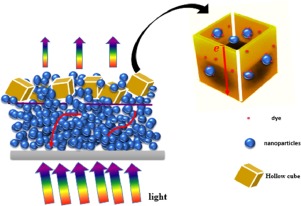Journal of the Taiwan Institute of Chemical Engineers ( IF 5.7 ) Pub Date : 2018-02-28 , DOI: 10.1016/j.jtice.2018.02.014 N. Sarvari , M.R. Mohammadi

|
Herein, we report the impact of light scattering mechanism on photovoltaic and photoelectrochemical performance of dye-sensitized solar cell (DSC) devices composed of TiO2 nanoparticles and hollow cubes. DSCs are designed by two different light scattering modes (i.e., mode I in form of single layer electrode containing nanoparticles and hollow cubes and mode II in the form of double layer electrode comprising active and scattering layers made of nanoparticles and mixtures of nanoparticles and hollow cubes, respectively). The synthesized anatase-TiO2 hollow cubes (200–400 nm) and nanoparticles (15–30 nm) are employed to enhance the optical length and light harvesting of photoanodes, respectively. Although the charge transfer resistances at Pt/electrolyte (RPt) and TiO2/dye/electrolyte (Rct) interfaces are decreased by mode I, it is not an appropriate approach for efficiency improvement of the devices due to hindering electrolyte diffusion and decreasing fill factor. In contrast, the photovoltaic performances of DSCs designed by mode II are successfully enhanced due to remarkable decrease in RPt and Rct. Not only mode II improves light scattering but also it makes a balance between electron transfer and dye sensitization, leading to an increase in cell efficiency up to 9.31% compared to 7.0% for the reference device composed of pure nanoparticles.
中文翻译:

光电阳极结构对TiO 2空心立方体和纳米粒子对染料敏化太阳能电池光散射机制和器件性能的影响
在这里,我们报告光散射机制对由TiO 2纳米粒子和空心立方体组成的染料敏化太阳能电池(DSC)器件的光伏和光电化学性能的影响。DSC通过两种不同的光散射模式进行设计(即,模式I为包含纳米粒子和空心立方体的单层电极形式,模式II为双层电极的形式,其包含由纳米颗粒以及纳米颗粒和空心立方体的混合物制成的活性层和散射层, 分别)。合成的锐钛矿型TiO 2空心立方体(200–400 nm)和纳米颗粒(15–30 nm)分别用于增强光阳极的光学长度和光收集。尽管电荷转移电阻在Pt /电解质(R Pt模式I降低了TiO 2 /染料/电解质(R ct)的界面,由于阻碍了电解质的扩散并降低了填充因子,因此不是提高器件效率的合适方法。相反,由于R Pt和R ct的显着降低,通过模式II设计的DSC的光伏性能得到了成功的增强。模式II不仅可以改善光散射,还可以在电子转移和染料敏化之间取得平衡,从而使电池效率提高了9.31%,而由纯纳米粒子组成的参考设备的电池效率提高了7.0%。



























 京公网安备 11010802027423号
京公网安备 11010802027423号